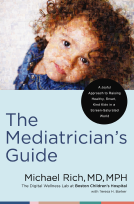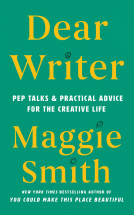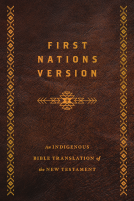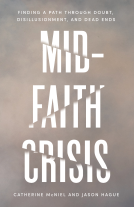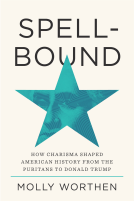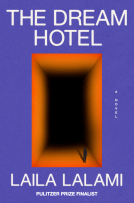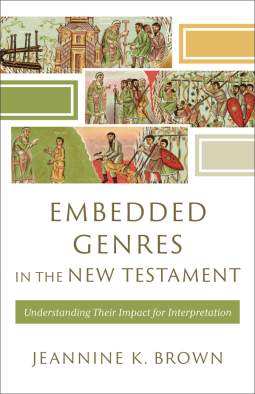
Embedded Genres in the New Testament
Understanding Their Impact for Interpretation
by Jeannine K. Brown
This title was previously available on NetGalley and is now archived.
Send NetGalley books directly to your Kindle or Kindle app
1
To read on a Kindle or Kindle app, please add kindle@netgalley.com as an approved email address to receive files in your Amazon account. Click here for step-by-step instructions.
2
Also find your Kindle email address within your Amazon account, and enter it here.
Pub Date Jun 25 2024 | Archive Date Jul 09 2024
Baker Academic & Brazos Press | Baker Academic
Talking about this book? Use #EmbeddedGenresintheNewTestament #NetGalley. More hashtag tips!
Description
This short, accessible book by a widely respected scholar and seasoned teacher introduces embedded genres, their impact on New Testament interpretation, and how they contribute to the message of the New Testament authors. Jeannine Brown offers hermeneutical guidance for interpreting embedded genres and explores the hermeneutical questions they raise. She focuses on three case studies of embedded genres that have been contested, underidentified, or underappreciated across the New Testament corpus: the Christ poem in Philippians 2, riddles in Matthew, and the household code in 1 Peter.
Students of the New Testament, pastors, and ministry leaders will value this work.
Advance Praise
“Brown’s book, although learned, is accessible and engaging. It is an invitation to the art of noticing, a call to sit and ruminate that will move readers of the New Testament to realize that, all too often, they have been seeing without seeing.”—Dale C. Allison Jr., Princeton Theological Seminary
“New Testament scholar Jeannine Brown draws from a deep well of experience and expertise in biblical interpretation. In Embedded Genres in the New Testament she offers a fresh look at how the microgenres within biblical books relate to their macrogenre and why that matters for more-faithful interpretation. Every interpreter of the Bible, whether a professional or a serious student, will benefit from Brown’s latest work.”—Karen H. Jobes, Gerald F. Hawthorne Professor Emerita of New Testament Greek and Exegesis, Wheaton College
“At its best, biblical exegesis is a journey of discovery, in which the attentive reader sees and hears the text afresh. Brown’s nuanced study takes her readers on just such a journey, both modeling fine-grained historical and literary attention to the dynamics of embedded genres and giving her readers the tools to do the same. This book is a boon to all serious teachers and students of the New Testament.”—Susan Eastman, associate research professor emerita, Duke Divinity School
“Brown has distinguished herself as an expert on biblical hermeneutics and exegesis, and here she illuminates ‘embedded genres,’ micro-literary pieces within a larger text. Brown offers a convincing case that readers benefit greatly from keen awareness of where these embedded units occur, how they deserve special attention, and how they affect the whole. She fills a gap left by textbooks that often miss this important topic.”—Nijay K. Gupta, professor of New Testament, Northern Seminary
“Sometimes I think good interpretation of the Bible is about slowing down—taking notice of, puzzling over, sitting with scriptural texts. Sometimes I think it’s about better readerly habits—listening (really listening!), asking good questions, exploring. Centering our attention on embedded literary forms in the Bible, on how they shape and are shaped by the books in which they appear, Jeannine Brown cultivates good habits by urging us to slow down and listen up. Her work with texts from Philippians, Matthew, and 1 Peter is stimulating on its own terms, and even more so as she addresses larger interpretive possibilities and invites us to do the same.”—Joel B. Green, senior professor of New Testament interpretation, Fuller Theological Seminary
“With her typical care and clarity, Jeannine Brown has given us an accessible exploration not only of the important idea of genres but also of how they can be nested inside one another. The introduction and case studies model for us a thoughtful and fruitful reading of Scripture.”—Jonathan T. Pennington, professor of New Testament, The Southern Baptist Theological Seminary
“The best approach to the interpretation of any biblical text begins with genre identification. In this book, Jeannine Brown polishes our ‘genre-sensitive’ lens to help us detect changes that reveal genres embedded within other forms. This hermeneutical practice sheds light on layers of meaning within the world of the text that have thus far gone unnoticed. Brown is both clear and convincing.”—David B. Capes, director, Lanier Theological Library
“A proper understanding of ancient genres is fundamental to biblical interpretation. But since each scriptural text consists of a variety of literary forms, the task of interpreters extends beyond merely identifying the characteristics of a single type of literature; readers must also account for the use of one genre in another. It is surprising, therefore, that this topic has received so little attention within modern scholarship. This book fills the lacuna perfectly, however. By carefully delineating the function and significance of embedded genres, Jeannine K. Brown has supplied readers of the New Testament with a valuable resource, one that brings fresh interpretive perspective to familiar texts.”—Travis B. Williams, Tusculum University
Available Editions
| EDITION | Other Format |
| ISBN | 9781540967619 |
| PRICE | $21.99 (USD) |
| PAGES | 160 |
Available on NetGalley
Featured Reviews
 Reviewer 1281795
Reviewer 1281795
Very interesting reflection on genre and how it affects our understanding of the New Testament writings. This added complexity to that conversation in a helpful way
EMBEDDED GENRES IN THE NEW TESTAMENT: Understanding Their Impact for Interpretation by Jeannine K. Brown is part of the Hayward Lecture and Acadia Studies in Bible and Theology series. As such, it aims to fill a gap for readers who want more than a popularized study, but less than a strictly academic tome. Kind of academic lite, so to speak. This book veers more toward the academic; for instance, a rudimentary knowledge of Greek would help with the multiple direct citations as well as familiarity with contemporary rhetorical genre study, where seemingly minor distinctions are given the weight Brown ascribes.
The book goes a step beyond the usual approach of analyzing the various Biblical genres. The author takes three examples where she discovers and separates genres within genres; then she examines how the two impact each other. These are the microgenre “Christ poem” in the macrogenre epistle in Philippians 2:6-11, the microgenre riddle across Matthew’s gospel narrative, and the household code in 1 Peter letter.
Of the three, the riddle section was the most interesting, but there is enough pastoral application amid the careful and well-articulated analysis to satisfy most readers (who understand the type of book it is.)
With thanks to NetGalley and Baker Publishing Group for an ARC of this book in exchange for an honest review.
This book is such a unique and insightful read on a topic that I wasn't sure I would get that much out of in the first place. Brown's writing is concise and clear and the format she uses in this book (hypothesis, evidence, conclusion) is very effective for what she is trying to communicate. The three examples she uses all make an interesting and unique point and her arguments are very well researched. I would have liked to see a little more on all of the genres found in the bible and how to recognize them outside of the examples set. She seems like such an expert on this topic and how the Bible is strucutred that I would have loved a few more chapters on how this fits the overall picture and how we can teach ourselves to recognize micro-genres in the old and new testament.
 Yakub T, Educator
Yakub T, Educator
As an expert on biblical hermeneutics and exegesis, Brown introduces to us embedded genres in the New Testament as a tool to interpret New Testament and how they contribute to the message of New Testament. This is a fresh look on how every part of microgenres of New Testament correlate with the macrogenres. So, serious students for sure will get benefits a lot from this book.
 Andrew P, Reviewer
Andrew P, Reviewer
"Embedded Genres in the New Testament" by Jeannine K. Brown is a compelling exploration of how distinct literary forms within the texts of the New Testament influence biblical interpretation. Brown's scholarly work delves into the nuances of embedded genres and their impact on the hermeneutical process, providing a fresh lens through which to view Scripture. The book is organized into a thoughtful structure that introduces the concept, discusses specific instances in the New Testament, and concludes with broader implications for interpretation.
Chapter 1: How Do Embedded Genres Matter?
In the opening chapter, Brown sets the stage by discussing the importance of recognizing genres within biblical texts to fully understand their meaning and intention. She asserts, "We won’t understand what we are reading if we don’t know what it is we are reading". This chapter addresses the challenges and methodologies for identifying and interpreting these genres, highlighting the complexity added by genres embedded within others. Brown emphasizes the need for heightened genre awareness, particularly when it comes to scripture, noting the often "hidden" nature of genre in biblical interpretation.
Chapter 2: Does Paul Break into Song in Philippians 2?
This chapter focuses on the 'Christ Poem' in Philippians 2, debating whether it should be considered a genuine hymn or poetic insertion within the letter. Brown examines the structure and language of the passage, arguing for its poetic nature based on its form and function within the text. She notes, "The rhythmic cadence and parallel patterns...are all poetic elements that set this text apart from the usual style of Paul".
Chapter 3: Is Jesus a Riddler in Matthew?
Here, Brown explores the use of riddles in the Gospel of Matthew, suggesting that this literary form plays a significant role in how Jesus' teachings are conveyed. She discusses the intricate relationship between the riddle form and the broader narrative techniques used in Matthew, pointing out that understanding this embedded genre can significantly affect the interpretation of Jesus' messages.
Chapter 4: Why Put a Household Code in the Middle of a Letter?
In this chapter, Brown examines the 'Haustafel' (household codes) in 1 Peter, questioning why such a structured genre appears within an epistolary context. She analyzes the function of these codes in reinforcing community and social ethics among early Christians. Brown argues that recognizing this embedded genre clarifies the apostle's intentions and enriches our understanding of early Christian domestic life.
Chapter 5: Conclusion: What Do Matryoshka Dolls and the New Testament Have in Common?
Brown concludes with an intriguing analogy, comparing the New Testament's structure to Russian nesting dolls, where smaller units are embedded within larger ones, each contributing to the whole's meaning. She synthesizes her findings from the previous chapters, emphasizing how a nuanced appreciation of embedded genres can lead to a more profound and enriched interpretation of the New Testament texts.
Conclusion
Jeannine K. Brown's "Embedded Genres in the New Testament" offers a meticulous and insightful examination of the complex literary forms within the New Testament and their implications for biblical hermeneutics. By illuminating the subtleties of these embedded genres, Brown provides readers and scholars alike with the tools to engage more deeply with the sacred texts, uncovering layers of meaning that may otherwise go unnoticed. This book is a valuable resource for anyone interested in the intricacies of scriptural interpretation and the rich tapestry of literary forms found within the Bible.
Readers who liked this book also liked:
Terry M. Wildman
Christian, OwnVoices, Religion & Spirituality

